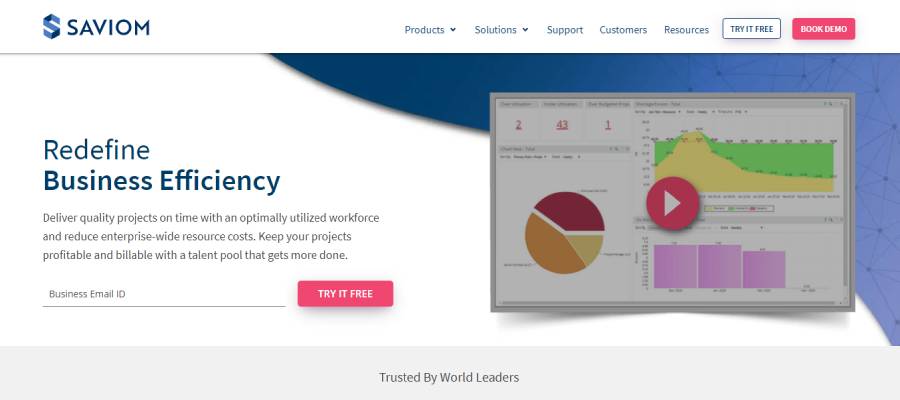Hello!
As an undertaking director, you’re continually haggling to track down the best assets for your group. That is on the grounds that having the right assets can represent the moment of truth in a task.
Asset scope quantification tools assist with guaranteeing that your business and tasks consistently keep steady over asset prerequisites and limit difficulties.
In this article, you’ll find out about the tools that help you design and deal with your group’s ability.
 You’ll likewise learn:
You’ll likewise learn:
- What is capacity planning?
- What is the importance of capacity planning?
- What types of capacity planning are there?
- What factors affect capacity planning?
Let’s get started.
What is capacity planning?
 Teams and organizations need the right resources to complete projects. These resources could be people, budget, or tools.
Teams and organizations need the right resources to complete projects. These resources could be people, budget, or tools.
This is what capacity planning is about. Capacity planning can be described as:
Accessing the right resources at the right moment will ensure that you get your project on time and with high quality. Having no access to the right resources can cause delays or even complete derailment of your project.
Why is capacity planning important?
Planning for capacity utilizationOptimizes business operations is. It also helps them.Understand the budget requirements acquiring, allocating, and managing resources.
In order to deliver quality work, project teams need the right resources.
The following is an extract from theGlobal Work Culture ReportOver 79 percent of employees will experience burnout in 2020. Your employees are at risk of burnout.
 These employees include:
These employees include:
- 2.6 times as likely to leave their current employer
- 220 percent less engaged
- 210 percent less likely to promote the business
Let’s now look at the types of capacity planning.
What are the types of capacity planning?
There are three types of capacity modeling techniques depending on:
- planning level,
- capacity goals,
- and, strategies used.
Based on the capacity planning level
 Capacity planning at the organization level: This is where the organization decides whether it has enough skilled workers. This helps to decide whether a hiring process is necessary.
Capacity planning at the organization level: This is where the organization decides whether it has enough skilled workers. This helps to decide whether a hiring process is necessary.
Allocation of resources at the project level: A manager at the project level identifies available resources and requests allocations for a project. Find out more resource allocation here.
Management of workload at the individual level: You must monitor each member of your team individually to prevent burnout. This will ensure that team members are not overwhelmed or under-worked.
Based on the capacity goal
Capacity for short-term use: Teams may increase or decrease the number of employees depending on seasonality or customer demand. Capacity plans for short-term can be for one day, one week, one month, or even a quarter.
 Capacity for medium-term use: This is a common option for projects lasting from one to three years.
Capacity for medium-term use: This is a common option for projects lasting from one to three years.
Capacity for the long-term: The time frame for planning depends on the industry. Experts often look at trends in the industry to forecast the demand for capacity. The forecasts are used to plan capacity.
Based on capacity fulfillment strategy
Strategy to increase lead capacity: This is when you increase your capacity to meet demand. This strategy can often lead to underutilized capacity.
Strategy to reduce lag capacity: The lag capacity strategy will only allow you to increase capacity when there is actual demand. This strategy can lead to overworked teams and delayed projects.
Strategy to match capacity: This is when the capacity is increased in small increments to meet demand.
What are the factors affecting team capacity planning?
Demand and availability are the basic factors that affect capacity planning. Three other factors are important when it comes to team project planning.
Project schedule: The project schedule determines the amount, time, and type of resources that are needed.
Human resources: Capacity planning is directly affected by compensation, training, and retention of employees within an organization.
External factors: Capacity planning can also be affected by government policies, union laws, budget cycles, and other factors.
What are the steps involved in resource capacity planning?
 We now know what capacity planning is. Let’s take a look at the steps involved.
We now know what capacity planning is. Let’s take a look at the steps involved.
- Current capacity: Firstly, you need to determine the current capacity. This will allow you to optimize your resources for your project.
- Determine demand: To estimate the demand for new resources capacity, you should first look at the project schedule and available resources. This demand can also be affected by external factors.
- Consolidation opportunities: Third, determine if it is possible to restructure existing resources in order to meet the demand. You can find underutilized members of your team who are able to meet the demand.
- Plan your capacity: Next, make a plan that outlines the actions you must take to meet the current and future demand.
- Finally, take action.
Planning capacity is an ongoing process. You need to constantly assess your capacity and plan for future demand. This should not be difficult if you have the right tools.
5 Best Resource Capacity Planning Tools for Teams
We’ve already learned a lot about capacity planning. We also learned about the process of capacity planning and the different types.
Let’s now look at some tools that can help make this process easier. Five tools will be discussed, ranging from the simple to the complex. While some tools are free, others can run into the thousands for enterprise tools.
1. Toggl Plan — Simple Project, Task & People Management
Toggle Plan is a simple tool for project planning and execution. It can also be used to manage workload and team capacity.
The team timeline view helps to manage team resources.
 This team timeline view displays:
This team timeline view displays:
- A big picture overview You can see who is working on which projects. This will allow you to see which team members are too spread out.
- Task estimates To help you find under- or overworked members of your team.
- Tem member Vacation and holiday plans so you can plan around incompatibility.
You can also zoom in on a week or quarter or a whole year. This allows for goal-based capacity planning, whether it is short, medium, or long term.
Toggle Plan’s project timeline makes creating a project plan easy. The plan timeline schedule assigns tasks to team members. These tasks are automatically synchronized with the team timeline.
Pricing
Toggl Plan, a project management tool, is simple and includes task management, project planning, and people management.
There is a free plan available for individuals with unlimited project plans. Paid plans for teams start at $9 per user per month. You get a 14-day trial.
2. Spreadsheets (MS Excel, Google Sheets, or OpenOffice Calc)

Spreadsheets can be used to plan capacity. A spreadsheet is a great tool for capacity planning. You can either create your own layout, or you can choose from one of the many templates available on the internet.
It can be difficult to keep spreadsheets current and error-free. The updating process is further complicated by sharing spreadsheets.
It can also be difficult to coordinate resources across teams, as each project has its own spreadsheet.
Pros
- Spreadsheets are used by most teams.
- There are many templates online. You don’t need to start from scratch.
Cons
- It can be difficult to keep your sheets current and track changes.
- It is nearly impossible to work in teams.
Pricing
Spreadsheet software is part of your office suite. It doesn’t cost extra. Your choice of office suite will determine the cost of your spreadsheet software. For a small team, it can cost as little as $100 per year.
3. Teamup — Shared online calendar for teams
Teamup is a shared calendar for teams.
 You can schedule work by placing people, events, or places on color-coded sub-calendars.
You can schedule work by placing people, events, or places on color-coded sub-calendars.
If you have a large team or are involved in multiple projects, Teamup can quickly become cluttered. There is no zoom feature that allows you to see a person’s capabilities.
- Use this calendar view to plan team meetings and other events.
- Sub-calenders for color-coded plans make it easier to manage visually.
Cons
- There is no way to gain a short-term or long-term view of your work capacity.
- The majority of office suites include a calendar app. You may not need to purchase a separate calendar for your team.
Pricing
The free plan only allows you to use 8 sub-calendars. Premium plans start at $8 per Month
4. 2Plan — Open source project planning software
2Plan is an open-source project planning software. It lacks the user interface and experience of other open-source tools that can help your team quickly get on board.
 Toggl Plan is similar to 2Plan.
Toggl Plan is similar to 2Plan.
It has basic time tracking capabilities, which is a plus. It is not a hosted solution.
You will need to download, install and maintain the software yourself.
Pros
- Open-source and free
- Available in a desktop version that can be used by one user
Cons
- Poor user experience. This will mean you’ll spend less time training your team.
- The tool will need to be installed and maintained by you.
Pricing
2Plan is an open-source, free capacity planning software.
5. Saviom— Enterprise resource planning tool
 Saviom is a capacity planning tool for large enterprises with formal operational efficiency improvement programs.
Saviom is a capacity planning tool for large enterprises with formal operational efficiency improvement programs.
It has all the necessary features to optimize resource usage. Small and medium teams might find the price and user experience intimidating.
Pros
- Comprehensive resource management tool.
- Ideal for enterprise users.
Cons
- Small and medium tools can find the user interface intimidating.
- For onboarding, you will need to complete formal education in resource management.
Pricing
Saviom is an enterprise tool so pricing information is not available to the public.
Conclusion
 Capacity planning is a tool that helps you and your team find the right resources at the right moment.
Capacity planning is a tool that helps you and your team find the right resources at the right moment.
We examined what capacity planning is and how it is done. We also looked at strategies and types of managing resource capacity. We also looked at the factors that influence it.
This process can be simplified by using capacity planning tools.
There are several capacity planning and resource management tools available. Toggl Plan is a good choice if you are looking for a simple tool to manage people, tasks, and projects.
Also read:
- What Are Cross-Border Payment Systems?
- Debt Recovery For Small Businesses: Essential Steps To Follow
- What Are the Best Lean Tools?
Thank you!
Join us on social networks!
See you!






